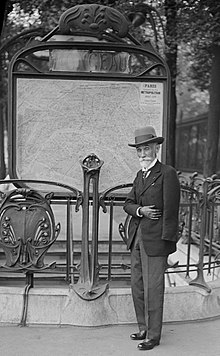Fulgence Bienvenüe
Fulgence Marie Auguste Bienvenüe (born January 27, 1852 in Uzel ( Département Côtes-d'Armor ), † August 3, 1936 in Paris ) was the chief engineer of the Paris Bridge and Road Construction Office and the "father" of Métro Paris .
Surname
Bienvenüe attached great importance to the trema when writing his name; but it has no effect on its pronunciation.
Origin and youth
Fulgence Bienvenüe was the thirteenth and last child of a Breton family and was extensively related to Marshal Foch - who had married Fulgence's great cousin Julie Bienvenüe, the great cousin of Fulgence on November 5, 1883 in the church of Saint-Michel in Saint-Brieuc - and to the Mazurié de family Kéroualin from Segré .
His father was a notary and was well educated; he had a major impact on his youngest son's successful studies. His grandfather, magistrate, lawyer, writer, polemicist was the author of a considerable work and in 1815 became a member of the Chambre des Représentants . His cousin Édouard Bienvenüe (1901-1980) was a notary in Mayenne from 1934 to 1965 and from 1940 to 1958 city councilor of this city.
resume
Bienvenüe passed his Baccalauréat at the age of 15. Three years later, in 1870, he was accepted into the École polytechnique , where he was almost shot with other technical school engineers during the Paris Commune . Two years later he entered the École Nationale des Ponts et Chaussées .
After graduating from school, he was named Chef d' Arrondissement in Normandy. He was given the job of directing the construction of two railway lines: the Fougères - Vire and Domfront - Alençon lines . He lost his left arm on February 25, 1881 (accident on the Pré-en-Pail - Mayenne line ) during a rather turbulent “expropriation visit”. From 1891 to 1893 he was chief engineer for the construction of the aqueduct by Avre .
Paris
In 1884 he was transferred to Paris and two years later worked for the city administration in the 8th section of the road construction office. He was involved in the construction of the Belleville funicular , which was inaugurated in September 1890. Bienvenüe also took part in the expansion of the Parc des Buttes-Chaumont and the breakthrough of the Avenue de la Republique. These projects earned him recognition and support.
The metro and other projects
In 1895, inspired by studies by Jean-Baptiste Berlier, he submitted a preliminary design for the metro . He presented a final project, which the city council approved on July 9, 1897. The project was declared non-profit by law on March 30, 1898; work began the following October 4th to be ready before the 1900 World's Fair.
The first stretch of the section between was stations Porte de Vincennes and Porte Maillot of Line 1 opened on 19 July 1900 by Bienvenüe. In the same year he was appointed officer of the Legion of Honor . In 1911 he became head of the Office for Streets, Lighting and City Cleaning in Paris; but he continued to work on the construction of the Paris Metro.
At the outbreak of World War I , at the age of 62, he applied to be drafted into the military, which was rejected in view of his competencies and his importance for the capital. In 1917 he became director of the port of Paris. He renewed the Canal de l'Ourcq and the Canal Saint-Denis .
Fulgence Bienvenüe decided on December 6, 1932, to retire at the age of 80.
Awards and commemorations

In 1929 Bienvenüe received the Grand Cross of the Legion of Honor ("GC LH"; French Grand-croix de la Legion ) from Marshal Ferdinand Foch in recognition of his services to the city of Paris . In 1933 the City Council of Paris decided to rename the Maine metro station and Place de Maine in honor of the "father of the metro".
Fulgence Bienvenüe died on August 3, 1936 in the French capital and was buried on August 7 in the Cimetière du Père-Lachaise cemetery with little public sympathy.
In 1987 a stamp was issued in his memory.
literature
- Claude Berton, Alexandre Ossadzow, Christiane Filloles: Fulgence Bienvenüe et la construction du métropolitain de Paris , Presses des Ponts, Paris 2007 ISBN 2859784225 ( excerpt from Google Books ).
Web links
- List of buildings by Fulgence Bienvenüe in the Base Mérimée of the French Ministry of Culture (French text)
Individual evidence
- ^ Gérard Roland: Stations de métro d'Abbesses à Wagram . Christine Bonneton, Clermont-Ferrand 2011, ISBN 978-2-86253-382-7 , pp. 146 .
- ^ Jean Tricoire: Un siècle de métro en 14 lignes. De Bienvenüe à Météor . 2nd Edition. La Vie du Rail, Paris 2000, ISBN 2-902808-87-9 , p. 131 .
| personal data | |
|---|---|
| SURNAME | Bienvenüe, Fulgence |
| ALTERNATIVE NAMES | Bienvenüe, Fulgence Marie Auguste |
| BRIEF DESCRIPTION | French engineer and the father of Métro Paris |
| DATE OF BIRTH | January 27, 1852 |
| PLACE OF BIRTH | Uzel , Côtes-d'Armor department |
| DATE OF DEATH | August 3, 1936 |
| Place of death | Paris |
